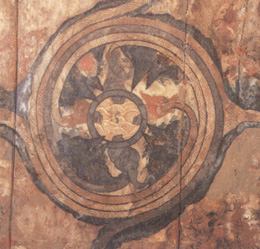|
|
|
Buddhism
|
Buddhism
More than 500 years before the birth
of Jesus Christ, the Indian Prince Siddhartha Gautama attained
Enlightenment and founded the great Eastern religion, Buddhism. Gradually spreading
through Asia, Buddhism became the
dominant spiritual force in Sikkim, Bhutan, Tibet, Mongolia, Sri Lanka, Burma,
Laos, Thailand, Kampuchea, Vietnam,
China, Korea and Japan, where it was
responsible for molding attitudes, tempering morality, coloring customs and
inspiring some of the world's finest art, sculpture and architecture.
Buddhism first appeared in Thailand
during the 3rd century B.C. when Theravada Buddhist missionaries dispatched
by the Buddhist Indian emperor Asoka
(267-227 B.C.), visited Suvannabhumi
(Suwannaphum), in the area of presentday Nakhon Fathom, a provincial capital
and site of the world's tallest Buddhist
monument. Once established, Buddhism
proved a durable and persuasive force,
so much so that the Mons migrating into
the area during the Dvaravati period
readily adopted it as their state religion.
At its inception in 600 B.C., Buddhism had been a reaction against Brahmanism,
the major contemporary Indian
religion which would later be absorbed
by Hinduism. Buddhism eschewed Brahmanism's emphasis on caste, on dogma
regarding sacrifice and ritual. At the same
time, it modified Brahmanic concepts of karma and rebirth.
Brahmanism answered the needs
for formalized celebration of man as a
higher being. Later, associated with the
monarchy, it provided ceremonies governing court etiquette, hierarchy and
ritual. Some aspects of Brahmanism
touch the lives of present-day Thais. The
traditional and formal Thai wedding ceremony is entirely Brahman in origin.
Brahmans still preside over various royal Thai
court rituals and Brahmanic shrines can
be found throughout the country.

The Tribhumikatha. a Buddhist
cosmology of the three planes of
existence, has frequently been
represented in various art forms
including mural paintings. :
Anodata Pond on top of the Sumeru
Mountain.
|
Buddhism also made deep inroads
into the animist beliefs which had held
sway in the Chao Phya river basin. Despite
its popularity, it never entirely supplanted
them. Through animism one could placate rampant, vengeful spirits. Buddhism,
on the other hand, spoke to the individual's inner being and provided him with
direction in ordering his daily life. More
importantly, it gave an explanation for
his existence and offered hope for a better
life in future incarnations.
Briefly, Buddhists believe that one's
life does not begin with birth and end
with death, but is a link in a chain of lives,
each conditioned by volitional acts (karma)
committed in previous existences. The
concept of karma, the law of cause and
effect, suggests that selfishness and craving result in suffering. Conversely,
compassion and love bring one happiness
and well-being. Therefore, only by eliminating desire can one find peace of
mind. The ideal Buddhist aspiration is
to attain perfection through Nirvana, an
indescribableป immutable state unconditioned by desire, suffering or further
rebirth, in which a person simply is, yet is
completely at one with his surroundings.
Later, the Thais in the northern part
of the present-day Thailand similarly embraced Buddhism, finding it
psychologically, emotionally and intellectually satisfying.
Moreover, Buddhism was easily adopted
because it did not conflict with animism
or Brahmanic ritual but fulfilled needs
not addressed by either.

A mural area in Wat Yai Intharam, Chon Buri, depicts the
Sumeru Mountain, the center of the
universe, supposedly supported by a
gigantic fish called Anon.
|
Buddhism gained wide acceptance
because its emphasis on tolerance and
individual initiative complemented the
Thais' cherished inner freedom. Fundamentally, Buddhism is an empirical way
of life. Free of dogma, it is a flexible moral,
ethical and philosophical framework within
which people find room to fashion their own salvations.
By the 7th century A.D., Mahayana
Buddhism from India started to enter the
region from Nakhon Si Thammarat. In
a stone inscription from Lop Buri, the in
digenous religion is described as being a
mixture of Theravada and Mahayana
Buddhism as well as Brahmanism,
Sukhothai's King Ramkhamhaeng
(1275-1317) established Theravada Buddhism as Thailand's dominant religion.
The elder of two major Buddhist schools
and closest to the Buddha's original teachings, it was practiced then much as it is
today. Buddhism reached its height
under the reign of King Ramkhamhaeng's
grandson, King Li Thai (1347-1368). It
was during King Li Thai's reign that about
30 volumes of the Buddhist scriptures
were studied and rewritten by the King
into one volume, the Tribhumikatha,
a treatise on Buddhist cosmology and
the three planes of existence: Sensuous,
Corporeal and Incorporeal. Not only
was it the first Buddhist treatise by a
Thai, it was also the first known Thai
Buddhist and didactic literary work. King Li Thai sent a mission of Buddhist monks
to study the religion in Sri Lanka. The Tribhumikatha's impact on religious arts
such as mural painting can be seen today
in many monasteries in various provinces.
Through the centuries Buddhism
has been the main driving force in Thai
cultural development. Much of classical
Thai art, particularly architecture, sculpture, painting and early literature, is really
Buddhist art. Then as now, Buddhism
colored everyday Thai life.
As Buddhism's benign influence
spread countrywide, Thais of all classes
submitted to its moral authority. Thai
monarchs subscribed to the Buddhist
ideals of kingship found in the original
Theravada scriptures, while farmers serenely accepted their station and fortune,
or misfortune, as logical karmic consequences of previous existences.

The headquarters of the World
Fellowship of Buddhists (WFB) is
located on Sukhumuit Road in
Bangkok.
|
With its emphasis on accepting human foibles and shortcomings as
inevitable, Buddhism helped forge and crystallize
the Thais' remarkable tolerance and
lack of prejudice, a major factor which
was to allow smooth, peaceful as similation of captives during medieval Thailand's
almost perpetual conflicts with neighboring countries. It also allowed the Thais
to embrace diverse cultural influences regardless of origin.
Responding to this openness to new
ideas, European missionaries could propagate their faiths in Thailand. Because
Buddhism answered so many of the
people's needs, they found few converts.
Although Buddhism became the
primary religion, Thais have always subscribed to the ideal of religious freedom.
While Thai constitutions have stipulated
that Thai kings must be Buddhist, monarchs are invariably titled 'Upholders of
All Religions'. Consequently, the government, through the Religious Affairs
Department, annually allocates funds to
finance religious education and construct,
maintain and restore monasteries, mosques and churches.
At present Thailand is the location
of the headquarters of the World Fellowship of Buddhists (WFB), an international
Buddhist organization, consisting of 75
regional centers in 34 countries, which
promotes coordination and cooperation
to enhance Buddhism throughout the world.
Princess Poon Pismai Diskul of Thailand has been voted consecutively as
president of the WFB four times. However, owing to her old age and ill health
the executive council, in B.E. 2523
(1980), unanimously invited H.E. Sanya
Dharmasakti, its vice-president, to be
acting-president, in charge of all administrative functions at the headquarters.
|
| | |
|
|